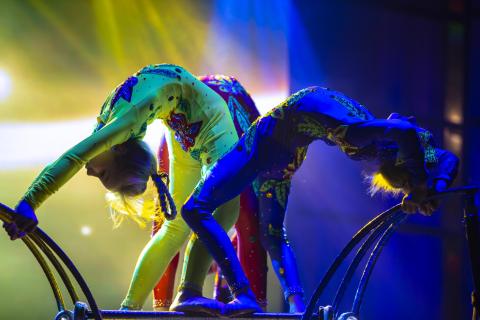Boston Conservatory at Berklee Gets Serious About Clowning

iStock photo
The word “circus” usually calls to mind big-tops filled with red-nosed clowns, lion tamers, and tightrope walkers—iconography that dates to the 19th century and was broadly popularized in the U.S. by Ringling Bros. and Barnum & Bailey’s traveling company. But the circus arts have roots that reach back much further in history (to 16th-century Italy’s commedia dell’arte, for instance) and encompass traditions from all over the world (such as the Peking opera’s clown role known as Chou).
Contemporary circus practices draw from all these sources to create a complex art form, blending experimental theater with cutting-edge dance and acrobatics. This fall, Boston Conservatory at Berklee will become the first academic institution in the country to offer a minor in cirque/circus arts, giving students the opportunity to study its cultural history and to learn performance skills that complement their majors in ways both obvious and unexpected.
“I think it’s long overdue,” says Tommy Neblett, dean of dance, who created the minor with colleague Theresa Lang, professor of theater. “I know circus training in academia sounds odd but I want to say, why does it sound odd? It makes perfect sense to have it in a conservatory setting.”
At Boston Conservatory, students will have the chance to study the topic from every angle, with a liberal arts course covering the history of the circus and a range of experiential classes based in both the Dance and Theater divisions. In addition to the history course, classes in tumbling, clowning, masks, and juggling are required for the minor. Elective courses currently include Physical Theater, Contact Skills, Commedia dell’Arte, Dance Improvisation, Vertical Barre, and Upside Down (which teaches principles of acro dance technique). In the 2025–2026 academic year, Boston Conservatory aims to add more electives covering aerial/acrobatic choreography, aerial straps, partnering acrobatics, and contortion.
Most of the minor’s core requirements have been a part of Boston Conservatory’s curriculum for years—a fact that underscores the foundational nature of circus arts training, Lang says. For instance, both the Dance and Theater divisions have long offered courses in clowning and masks; and contemporary theater students have been encouraged to study acrobatics since the program’s inception.
While the merits of acrobatics for dancers are self-evident, actors benefit from the training in surprising ways, according to Lang. “It makes perfection extra impossible and really releases a lot of the burden of failure,” she says. “Trying to reincorporate play into performance is something that is an incredibly important part of our practice.”
Clowning also emphasizes playful improvisation and teaches students to express themselves through simple characterization, using big, bold gestures. “The basis of physical theater—the legacies that we draw from—incorporate clowning,” she says. “There’s a totality and almost like a purity of character that we don’t tend to see with psychologically complex characters.”
Neblett finds cirque training to be a logical extension of Boston Conservatory’s dance curriculum, in particular its B.F.A. in commercial dance. Aerial work, acrobatics, and tumbling have become mainstream components of popular dance, he says, pointing to Usher’s 2024 Super Bowl halftime show as a recent example. Broadway, too, has seen popular shows like Water for Elephants combining musical theater with aspects of circus performance.
And of course, the ever-growing popularity of Cirque du Soleil has changed the performing arts landscape, expanding audiences’ appetite for the circus arts. While it may be the best-known contemporary company, many others have been pushing the boundaries for decades. Campagnia Finzi Pasca has staged acrobatic theater productions inspired by surrealist Salvador Dalí and Russian author Anton Chekov; and Cirque Kalabanté’s latest show takes its cues from daily life in Guinea, incorporating live Afro-jazz music with percussionists and kora players.
For a longtime Cirque du Soleil fan like Neblett, creating the new minor has been an opportunity to merge personal and educational passions. “I saw them maybe 20 years ago and just fell in love with them because it was such an amalgamation of music and dance and theater and visual arts and sports and acrobatics.”
Launching college-level circus studies is a logical next step for Boston Conservatory, Neblett says, as the performance world continues to expand and combine disciplines, demanding more from artists than ever before.
“The more skills a performer has, the better, because the lines are now so blurred between dance and theater and music and visual arts,” he says. “It’s the perfect time to do this.”
Learn more about Boston Conservatory’s new cirque/circus arts minor and explore the Conservatory’s leading B.F.A. programs in contemporary dance and commercial dance.
